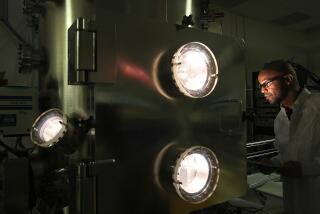As Virgin Galactic notches another test flight, its next space planes take shape
Virgin Galactic’s SpaceShipTwo space plane reached suborbital space Friday for the second time, then landed back on the runway at the Mojave Air and Space Port about an hour after liftoff.
Steps away from the flight line, in a 48,000-square-foot hangar, the two successors to the craft — which is named VSS Unity — are taking shape. These are also SpaceShipTwo vehicles, fine-tuned based on VSS Unity’s experiences, and they’re intended to carry paying customers to space one day.
Company officials emphasize that Virgin Galactic is still very much in the test-flight phase. The company reached suborbital space for the first time during a December flight but wants to make sure it can repeat that achievement consistently.
The space plane’s Friday test, its fifth powered flight, began shortly after 8 a.m. Pacific time. The craft was carried by the larger, twin-fuselage plane known as WhiteKnightTwo to an altitude of about 45,000 feet, then released in midair to blast off on its own power around 8:53 a.m.
Two minutes later, Virgin Galactic tweeted, “SpaceShipTwo, welcome back to space.”
The space plane reached a speed of Mach 3.04 and an altitude of 295,007 feet — its fastest and highest flight yet, according to the company.
VSS Unity was flown by pilots Dave Mackay and Michael Masucci. For the first time ever, it also had a third crew member aboard — chief astronaut instructor Beth Moses — to give feedback on the cabin experience and “spaceflight environment from the perspective of people in the back,” Virgin Galactic tweeted. The company said Moses took off her seat belt upon reaching suborbital space and floated freely in the cabin, a new experience aboard a Virgin Galactic craft.
More than 600 customers have put down deposits of up to $250,000 each to experience several minutes of weightlessness while watching the sky fade from light blue to the blackness of space.
To provide that, Virgin Galactic needs to churn out more space planes.
“We’ve chosen to do some design enhancements on the next spaceship, mostly about manufacturability,” said Enrico Palermo, president of Spaceship Co., Virgin’s spacecraft manufacturing arm. “We’re going to build more of them.”
The shop floor at one of Spaceship Co.’s Mojave hangars was buzzing on a recent weekday, with teams of people working on aspects of the next two SpaceShipTwo space planes.
“At a [Boeing] 737 plant, they’re building one [airplane] a day; they’re very high-rate,” Palermo said. “We may build a dozen spaceships [total]. And so our shop floor changes every day.”
The company has just more than 500 employees.
Composite materials are the company’s core competency, Palermo said. Both SpaceShipTwo and the carrier aircraft that powers the first leg of its trip are constructed from carbon fiber.
Composite materials have the twin attributes of strength and light weight, a combination derived from sandwiching honeycomb-like materials between sheets of carbon fiber. Technicians at the Spaceship Co. facility wore purple gloves while working with the materials — human fingers have oils that can “contaminate the product,” Palermo said.
The company began building the next SpaceShipTwo space plane in 2017 and hopes to finish it this year. Once the design is finalized, building a SpaceShipTwo craft could take as little as 18 months from start to finish, Palermo said.
Twitter: @smasunaga







